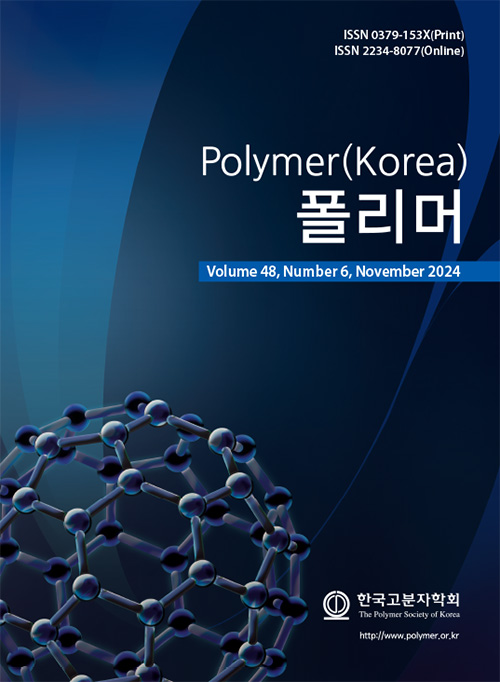- Study on Rubber Toughening of Aliphatic Polyketone via Polyether-block-polyamide
Department of Aero-Materials Engineering, Jungwon University, 85 Munmu-ro, Goesan-eup, Goesan-gun, Chungbuk 28024, Korea
*Advanced Materials Science and Engineering, College of Engineering, Kongju National University, 1223-24, Cheonan-daero, Seobuk-gu, Cheonan, Chungnam 31080, Korea- Polyether-block-polyamide를 이용한 지방족 폴리케톤의 고무 강인화에 관한 연구
중원대학교 항공재료공학과, *공주대학교 신소재공학과
Reproduction, stored in a retrieval system, or transmitted in any form of any part of this publication is permitted only by written permission from the Polymer Society of Korea.
To enhance the impact strength of aliphatic polyketone (PK), polyether-block-polyamide (PEBA) was utilized as an elastomer. PK/PEBA blends were prepared using five different PEBAs with various types and compositions of polyether and polyamide, and their mechanical properties, morphology, and thermal properties were examined. Among the five types of PEBA, PA6PEO60, comprising polyamide 6 (PA6) and poly(ethylene oxide) (PEO), exhibited the most effective rubber toughening efficiency. PK/PEBA blends containing 20% PA6-b-PEO demonstrated a significant increase in impact strength by 100 to 250% and displayed a homogeneous morphology. Additionally, PA6-b-PEO notably reduced the melting temperature and heat of fusion of PK. However, it was observed that PA6-b-PEO, which exhibited the highest compatibility with PK, induced the most substantial crosslinking reaction of PK among the five types of PEBA, which should be clarified in future studies.
지방족 폴리케톤(aliphatic polyketone, PK)의 내충격성을 향상시키기 위하여 polyether-block-polyamide(PEBA)를 탄성체로 사용하였다. Polyether와 polyamide의 종류 및 조성이 다른 5 종의 PEBA를 사용하여 PK/PEBA 블렌드를 제조하였고 기계적 물성, 모폴로지, 열적 특성 등을 조사하였다. 5종의 PEBA 중에서 polyamide 6(PA6)와 poly(ethylene oxide) (PEO)로 이루어진 PA6-b-PEO이 가장 우수한 고무 강인화 성능을 나타냈다. PA6-b-PEO를 20% 혼합한 PK/PEBA 블렌드는 충격 강도가 100-250% 증가하였고 균일한 모폴로지를 나타냈다. 또한 PA6-b-PEO가 PK의 용융 온도 및 용융열을 감소시켰다. PK에 PA6-b-PEO의 투입에 따라 충격강도가 크게 증가했는데 이는 PA6-b-PEO의 고무 강화 효과보다는 PA6-b-PEO 상의 PA6 때문에 PK의 가교화가 촉진 되었기 때문인 것으로 추정된다.
Keywords: aliphatic polyketone, polyether-block-polyamide, rubber toughening, thermal stability.
- Polymer(Korea) 폴리머
- Frequency : Bimonthly(odd)
ISSN 0379-153X(Print)
ISSN 2234-8077(Online)
Abbr. Polym. Korea - 2024 Impact Factor : 0.6
- Indexed in SCIE
 This Article
This Article
-
2024; 48(6): 615-622
Published online Nov 25, 2024
- 10.7317/pk.2024.48.6.615
- Received on May 21, 2024
- Revised on Aug 11, 2024
- Accepted on Aug 21, 2024
 Correspondence to
Correspondence to
- Younggon Son
-
Advanced Materials Science and Engineering, College of Engineering, Kongju National University, 1223-24, Cheonan-daero, Seobuk-gu, Cheonan, Chungnam 31080, Korea
- E-mail: sonyg@kongju.ac.kr









 Copyright(c) The Polymer Society of Korea. All right reserved.
Copyright(c) The Polymer Society of Korea. All right reserved.